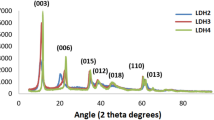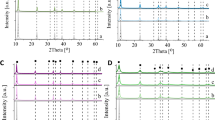Abstract
Advanced oxidation processes such as photocatalysis have assumed enormous importance in the scientific field as viable sustainable alternatives to be applied to the elimination of persistent organic pollutants present in water reservoirs for human consumption. Persistent organic compounds like pesticides that belong to the chlorophenol family are a global public health priority since they are associated with serious diseases like cancer and can even cause death at low concentrations of prolonged exposure. This work proposes the use of activated Ni/Al layered double hydroxides as photocatalysts for the degradation of 2,4-dichlorophenol. The study variables associated with the properties of the catalysts were the Ni/Al metal ratio as well as the synthesis conditions. To determine the structural properties of catalytic precursors and catalysts, the techniques of XRD, FTIR, UV-DR, DGTA, TPD, SEM-EDS and TEM were used. The photodegradation tests were carried out in a Bach type reactor with a high energy uv lamp. The results of the photocatalytic degradation of 2,4-dichlorophenol in aqueous solution showed good photocatalytic activity with a degradation efficiency of up to 94% attributed to the presence of Ni in the crystalline and amorphous structures of NiO–NiAl2O4 oxides by means of a combined oxidation-reduction mechanism due to the effect of holes and superoxide and hydroxyl radicals not associated with the memory effect of reconstruction of layered double hydroxides.




















Similar content being viewed by others
References
Nugen S, Baeumner HJ (2008) Trends and opportunities in food pathogen detection. Anal Bioanal Chem 391:451–454
Nakata K, Fujishima A (2012) TiO2 photocatalysis: design and applications. J Photochem Photobiol C 13:169–189. https://doi.org/10.1016/j.jphotochemrev.2012.06.001
Jack R, Ayoko G, Adebajo M, Frost R (2015) A review of iron species for visible-light photocatalytic water purification. Environ Sci Pollut Res 22:7439–7449. https://doi.org/10.1007/s11356-015-4346-5
Chong MN, Jin B, Chow CWK, Saint C (2010) Recent developments in photocatalytic water treatment technology: a review. Water Res 44:2997–3027
Fajrina N, Tahir M (2019) A critical review in strategies to improve photocatalytic water splitting towards hydrogen production. Int J Hydrogen Energ 44:540–577
Athanasekou CP, Likodimos V, Falaras P (2018) Recent developments of TiO2 photocatalysis involving advanced oxidation and reduction reactions in water. J Environ Chem Eng 6(6):7386–7394. https://doi.org/10.1016/j.jece.2018.07.026
Fujishima A, Honda K (1972) Electrochemical photolysis of water at a semiconductor electrode. Nature 238:37–38
Zhao C, Liu L, Rao G, Zhao H, Wang L, Xu J, Li Y (2015) Synthesis of novel MgAl layered double oxide grafted TiO2 cuboids and their photocatalytic activity on CO2 reduction with water vapor. Catal Sci Technol 5:3288. https://doi.org/10.1039/c5cy00216h
Choquette-Labbé M, Shewa WA, Lalman JA, Shanmugam SR (2014) Photocatalytic degradation of phenol and phenol derivatives using a nano-TiO2 catalyst: integrating quantitative and qualitative factors using response surface methodology. Water 6:1785–1806. https://doi.org/10.3390/w6061785
Abdel-Maksoud Y, Imam E, Ramadan A (2016) TiO2 solar photocatalytic reactor systems: selection of reactor design for scale-up and commercialization: analytical. Rev Catal 6:138. https://doi.org/10.3390/catal6090138
Österlund L, Mattsson A, Brischetto M, Byberg JJ, Stefanov BI, Ji YX, Niklasson GA (2018) Spectral selective solar light enhanced photocatalysis: TiO2/TiAlN bilayer films. Top Catal 61:1607–1614. https://doi.org/10.1007/s11244-018-1011-5
Chen H, Liu XY, Hao XD, Zhang YX (2016) Facile biphasic synthesis of TiO2–MnO2 nanocomposites for photocatalysis. Ceram Int 42:19425–19428. https://doi.org/10.1016/j.ceramint.2016.08.160
Zhou P, Le V, Xie YJ, Xu J (2017) Studies on facile synthesis and properties of mesoporous CdS/TiO2 composite for photocatalysis applications. J Alloy Compd 692:170–177. https://doi.org/10.1016/j.jallcom.2016.09.039
Mazierski P, Mikolajczyk A, Bajorowicz B, Malankowska A, Zaleska-Medynska A, Nadolna J (2018) The role of lanthanides in TiO2-based photocatalysis: a review. Appl Catal B 233:301–317. https://doi.org/10.1016/j.apcatb.2018.04.019
Zhou P, Le Z, Xie Y, Fang J, Xu J (2017) Studies on facile synthesis and properties of mesoporous CdS/TiO2 composite for photocatalysis applications. J Alloy Compd 692:170–177. https://doi.org/10.1016/j.jallcom.2016.09.039
Marchelek M, Grabowska E, Klimczuk T, Lisowski W, Mazierski P, Zaleska-Medynska A (2018) Visible light photocatalysis employing TiO2/SrTiO3-BiOI composites: surface properties and photoexcitation mechanism. Mol Catal 452:154–166. https://doi.org/10.1016/j.mcat.2018.04.006
Chung SG, Chang YS, Choi JW, Baek KY, Hong SW, Yun ST, Lee SH (2013) Photocatalytic degradation of chlorophenols using star block copolymers: removal efficiency, by-products and toxicity of catalyst. Chem Eng J 215–216:921–928. https://doi.org/10.1016/j.cej.2012.11.070
Jimenez-Tototzintle M, Jales I, da Silva S, Guimaraes PR, Mendes E (2018) Removal of contaminants of emerging concern (CECs) and antibiotic resistant bacteria in urban wastewater using UVA/TiO2/H2O2 photocatalysis. Chemosphere 210:449–457. https://doi.org/10.1016/j.chemosphere.2018.07.036
Irawaty W, Soetaredjo FE, Ayucitra A (2014) Understanding the relationship between organic structure and mineralization rate of TiO2-mediated photocatalysis. Procedia Chem 9:131–138
Al-Mamun MR, Kader S, Islam MS, Khan MZH (2019) Photocatalytic activity improvement and application of UV-TiO2 photocatalysis in textile wastewater treatment: a review. J Environ Chem Eng 7:103248. https://doi.org/10.1016/j.jece.2019.103248
Hu X, Hu X, Peng Q, Zhou L, Tan X, Jiang L, Tang C, Wang H, Liu S, Wang Y, Ning Z (2020) Mechanisms underlying the photocatalytic degradation pathway of ciprofloxacin with heterogeneous TiO2. Chem Eng J 380:122366. https://doi.org/10.1016/j.cej.2019.122366
Holcombe GW, Phipps GL, Fiandt JT (1982) Effects of phenol, 2,4-dimethylphenol, 2,4-dichlorophenol, and pentachlorophenol on embryo larval, and early-juvenile Fathead Minnows (Pimephales promelas). Arch Environ Contam Toxicol 11:73–78
Boyd EM, Killhanm K, Meharg AA (2001) Toxicity of mono-, di- and tri-chlorophenols to lux marked terrestrial bacteria, Burkholderia species Rasc c2 and Pseudomonas fluorescens. Chemosphere 43:157–166
Zheng D, Jiao H, Zhong H, Qiu J, Yan X, Duan Q, Chai L (2018) Chlorophenols in marine organisms from the southern coast of Hangzhou Bay, China, and an assessment of risks posed to human health. J Oceanol Limnol 36(3):726–737. https://doi.org/10.1007/s00343-018-7039-3
Kukkonen JVK (2002) Lethal body residue of chlorophenols and mixtures of chlorophenols in benthic organisms. Arch Environ Contam Toxicol 43:214–220. https://doi.org/10.1007/s00244-002-1174-7
Yu J, Wang T, Rtimi S (2019) Magnetically separable TiO2/FeOx/POM accelerating the photocatalytic removal of the emerging endocrine disruptor: 2,4-dichlorophenol. Appl Catal B 254:66–75. https://doi.org/10.1016/j.apcatb.2019.04.088
Ruan X, Liu H, Wang J, Zhao D, Fan X (2019) A new insight into the main mechanism of 2,4-dichlorophenol dechlorination by Fe/Ni nanoparticles. Sci Total Environ 697:133996. https://doi.org/10.1016/j.scitotenv.2019.133996
Diao ZH, Yan L, Dong FX, Qian W, Deng QH, Kong LJ, Yang JW, Lei ZX, Du JJ, Chu W (2020) Synergism with Cd(II) immobilization in a contaminated soil. Chem Eng J 379:122313. https://doi.org/10.1016/j.cej.2019.122313
Diao XH, Yan L, Dong FX, Qian W, Deng QH, Kong LJ, Yang JW, Lei ZX, Du JJ, Chu W (2009) ZnO/Mg–Al layered double hydroxides as strongly adsorptive photocatalysts. Res Chem Intermed 35:685–692. https://doi.org/10.1007/s11164-009-0094-9
Wu SZ, Li N, Zhang WD (2014) Attachment of ZnO nanoparticles onto layered double hydroxides microspheres for high performance photocatalysis. J Porous Mater 21:157–164. https://doi.org/10.1007/s10934-013-9760-9
Cavani F, Trifiro F, Vaccari A (1992) Hydrotalcite-type anionic clays: preparation, properties and applications. Catal Today 11:173–301
Roelofs JCAA, Bokhoven JA, Dillen AJ, Jong KP (2002) The thermal decomposition of Mg ± Al hydrotalcites: effects of interlayer anions and characteristics of the final structure. Chem Eur J 8:5571–5579
Yahyaoui R, Sanchez PE, Pérez LA, Nahdi K, Criado JM (2018) Synthesis, characterization and combined kinetic analysis of thermal decomposition of hydrotalcite (Mg6Al2(OH)16CO3·4H2O). Thermochim Acta 667:177–184. https://doi.org/10.1016/j.tca.2018.07.025
Nguyen HKD, Nguyen HV, Nguyen VA (2018) Effect of synthetic conditions on the structure of mesoporous Mg-Al-Co hydrotalcite. J Mol Struct 1171:25–32. https://doi.org/10.1016/j.molstruc.2018.05.087
Zhang D, Zhao G, Yu J, Yan T, Zhu M, Jiao F (2016) Thermodynamic and kinetic studies of effective adsorption of 2,4,6-trichlorophenol onto calcined Mg/Al-CO3 layered double hydroxide. J Wuhan Univ Technol 31:1211–1218. https://doi.org/10.1007/s11595-016-1514-5
Yang B, Liu J, Liu Z, Wang Y, Cai J, Peng L (2019) Preparation of chitosan/Co-Fe-layered double hydroxides and its performance for removing 2,4-dichlorophenol. Environ Sci Pollut Res 26:3814–3822. https://doi.org/10.1007/s11356-018-3886-x
Zhou S, Li C, Zhao G, Liu L, Yu J, Jiang X, Jiao F (2019) Heterogeneous co-activation of peroxymonosulfate by CuCoFe calcined layered double hydroxides and ultraviolet irradiation for the efficient removal of p-nitrophenol. J Mater Sci Mater Electron 30:19009–19019. https://doi.org/10.1007/s10854-019-02258-0
Prasad C, Tang H, Liu W (2018) Magnetic Fe3O4 based layered double hydroxides (LDHs) nanocomposites (Fe3O4/LDHs): recent review of progress in synthesis, properties and applications. J Nanostruct Chem 8:393–412. https://doi.org/10.1007/s40097-018-0289-y
Zheng K, Song Y, Wang X, Li X, Mao X, Wang D (2019) Understanding the electrode reaction process of dechlorination of 2,4-dichlorophenol over Ni/Fe nanoparticles: effect of pH and 2,4-dichlorophenol concentration. J environ sci 84:13–20. https://doi.org/10.1016/j.jes.2019.01.012
Yang B, Cai J, Wei S, Nie N, Liu J (2020) Preparation of chitosan/NiFe-layered double hydroxides composites and its fenton–like catalytic oxidation of phenolic compounds. J Polym Environ 28:343–353. https://doi.org/10.1007/s10924-019-01614-9
Alzhrani G, Ahmed NS, Aazam ES, Saleh TS, Mokhtar M (2019) Novel efficient Pd-free Ni-layered double hydroxide catalysts for a suzuki C-C coupling reaction. Chem Select. https://doi.org/10.1002/slct.201900890
Tsai KJ, Ni CS, Chen HY, Huang JH (2020) Single-walled carbon nanotubes/Ni–Co–Mn layered double hydroxide nanohybrids as electrode materials for high-performance hybrid energy storage devices. J Power Sources 4541:2020227912. https://doi.org/10.1016/j.jpowsour.2020.227912
Klemkaite K, Prosycevas I, Taraskevicius R, Khinsky A, Kareiva A (2011) Synthesis and characterization of layered double hydroxides with different cations (Mg, Co, Ni, Al), decomposition and reformation of mixed metal oxides to layered structure. Cent Eur J Chem 9(2):275–282. https://doi.org/10.2478/s11532-011-0007-9
Belskaya OB, Leonteva NN, Gulyaeva TI, Cherepanova SV, Talzi VP, Drozdov VA, Likholobov VA (2013) Influence of a doubly charged cation nature on the formation and properties of mixed oxides MAlOx (M = Mg2+, Zn2+, Ni2+) obtained from the layered hydroxide precursors. Russ Chem Bull 62(11):2349–2361
Zhao L, Li X, Hao CE, Raston CL (2012) SO2 adsorption and transformation on calcined NiAl hydrotalcite-like compounds surfaces: An in situ FTIR and DFT study. Appl Catal B 117– 118:339. https://doi.org/10.1016/j.apcatb.2012.01.034
Mardani HR (2017) (Cu/Ni)–Al layered double hydroxides@Fe3O4 as efficient magnetic nanocomposite photocatalyst for visible-light degradation of methylene blue. Res Chem Intermed 43:5795–5810. https://doi.org/10.1007/s11164-017-2963-y
Foruzin LJ, Rezvani Z, Nejati K (2018) Preparation of two-color photoluminescence emission based on azo dye-layered double hydroxide systems and controlling photoluminescence properties of Allura Red AC. J Iran Chem Soc 15:2649–2658. https://doi.org/10.1007/s13738-018-1453-5
Castañeda C, Tzompantzi F, Gómez R, Rojas H (2016) Enhancedphotocatalyticdegradation of4-chlorophenoland2,4-dichlorophenolon insituphosphatedsol-gelTiO2. J Chem Technol Biotechnol 91:2170–2178. https://doi.org/10.1002/jctb.4943
Coenen K, Gallucci F, Mezari B, Hensen E, Annaland M (2018) An in-situ IR study on the adsorption of CO2 and H2O on hydrotalcites. J CO2 Util 24:228–239
Wierzbicki D, Baran R, Dębek R, Motak M, Gálvez ME, Grzybek T, Da Costa P, Glatzel P (2018) Examination of the influence of La promotion on Ni state in hydrotalcite-derived catalysts under CO2 methanation reaction conditions: operando X-ray absorption and emission spectroscopy investigation. Appl Catal B 232(15):409–419. https://doi.org/10.1016/j.apcatb.2018.03.089
Wang W, Xu Z, Guo Z, Jiang C, Chu W (2015) Layered double hydroxide and related catalysts for hydrogen production and a biorefinery. Chin J Catal 36:139–147. https://doi.org/10.1016/S1872-2067(14)60229-1
Lu B, Zhuang J, Du J, Gu F, Xu G, Zhong Z, Liu Q, Su F (2019) Highly dispersed Ni nanocatalysts derived from NiMnAl-hydrotalcites as high-performing catalyst for low-temperature syngas methanation. Catalysts 9:282. https://doi.org/10.3390/catal9030282
Acknowledgements
The authors thank CONACYT, UAM-I and UG for your support and funding. Additionally, we thank Dr. Mirella Gutiérrez A. from UAM-A and Dr. Raul Pérez-Hernandez from ININ for their scientific-technological support.
Author information
Authors and Affiliations
Corresponding authors
Ethics declarations
Conflict of interest
The authors declare no conflict of interest.
Additional information
Publisher's Note
Springer Nature remains neutral with regard to jurisdictional claims in published maps and institutional affiliations.
Rights and permissions
About this article
Cite this article
Ramos-Ramírez, E., Gutiérrez-Ortega, N.L., Tzompantzi-Morales, F. et al. Photocatalytic Degradation of 2,4-Dichlorophenol on NiAl-Mixed Oxides Derivatives of Activated Layered Double Hydroxides. Top Catal 63, 546–563 (2020). https://doi.org/10.1007/s11244-020-01269-0
Published:
Issue Date:
DOI: https://doi.org/10.1007/s11244-020-01269-0




